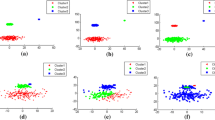Abstract
We discuss Learning in parallel universes as a learning concept that encompasses the simultaneous analysis from multiple descriptor spaces. In contrast to existing approaches, this approach constructs a global model that is based on only partially applicable, local models in each descriptor space. We present some application scenarios and compare this learning strategy to other approaches on learning in multiple descriptor spaces. As a representative for learning in parallel universes we introduce different extensions to a family of unsupervised fuzzy clustering algorithms and evaluate their performance on an artificial data set and a benchmark of 3D objects.
Similar content being viewed by others
References
3D Benchmark (2008) Konstanz 3D model search engine. http://merkur01.inf.uni-konstanz.de/CCCC/. Accessed 20 March 2009
Aggarwal CC, Yu PS (2000) Finding generalized projected clusters in high dimensional spaces. In: Chen W, Naughton JF, Bernstein PA (eds) Proceedings of the 2000 ACM SIGMOD international conference on management of data, May 16–18, 2000, Dallas, Texas, USA, ACM, pp 70–81
Agrawal R, Gehrke J, Gunopulos D, Raghavan P (1998) Automatic subspace clustering of high dimensional data for data mining applications. In: Proceedings of the 1998 ACM SIGMOD international conference on management of data, ACM Press, New York, NY, USA, pp 94–105
Aggarwal CC, Wolf JL, Yu PS, Procopiuc C, Park JS (1999) Fast algorithms for projected clustering. In: Proceedings of ACM SIGMOD international conference on management of data, pp 61–72
Alqadah F, Bhatnagar R (2008) An effective algorithm for mining 3-clusters in vertically partitioned data. In: CIKM ’08: proceeding of the 17th ACM conference on information and knowledge management, ACM, New York, NY, USA, pp 1103–1112. http://doi.acm.org/10.1145/1458082.1458228
Bender A, Glen RC (2004) Molecular similarity: a key technique in molecular informatics. Org Biomol Chem 2(22): 3204–3218
Bezdek JC (1981) Pattern recognition with fuzzy objective function algorithms. Plenum Press, New York
Bickel S, Scheffer T (2004) Multi-view clustering. In: Proceedings of the fourth IEEE international conference on data mining (ICDM’04), pp 19–26
Blum A, Mitchell T (1998) Combining labeled and unlabeled data with co-training. In: Proceedings of the eleventh annual conference on computational learning theory (COLT’98), ACM Press, pp 92–100
Bustos B, Keim DA, Saupe D, Schreck T, Vranic DV (2004) Using entropy impurity for improved 3D object similarity search. In: Proceedings of IEEE international conference on multimedia and expo (ICME’2004), pp 1303–1306
Bustos B, Keim DA, Saupe D, Schreck T, Vranić DV (2005) Feature-based similarity search in 3D object databases. ACM Comput Surv (CSUR) 37(4): 345–387
Bustos B, Keim DA, Saupe D, Schreck T, Vranić DV (2006) An experimental effectiveness comparison of methods for 3D similarity search. Special issue on multimedia contents and management in digital libraries. Int J Digit Libr 6(1): 39–54
Dasgupta S, Littman ML, McAllester DA (2001) PAC generalization bounds for co-training. In: NIPS, pp 375–382
Friedman JH, Meulmany JJ (2004) Clustering objects on subsets of attributes. J R Stat Soc 66(4): 815–849
Kailing K, Kriegel HP, Pryakhin A, Schubert M (2004) Clustering multi-represented objects with noise. In: PAKDD, pp 394–403
Klawonn F (2004) Fuzzy clustering: insights and a new approach. Mathware Soft Comput 11: 125–142
Kriegel HP, Kröger P, Zimek A (2009) Clustering high-dimensional data: a survey on subspace clustering, pattern-based clustering, and correlation clustering. ACM Trans Knowl Discov Data (TKDD) 3(1): 1–58
Krishnapuram R, Keller JM (1993) A possibilistic approach to clustering. IEEE Trans Fuzzy Syst 1(2): 98–110
Krishnapuram R, Keller JM (1996) The possibilistic c-means algorithm: insights and recommendations. IEEE Trans Fuzzy Syst 4: 385–393
Patterson DE, Berthold MR (2001) Clustering in parallel universes. In: IEEE conference on systems, man and cybernetics, IEEE Press
Rüping S, Scheffer T (eds) (2005) Proceedings of the ICML 2005 workshop on learning with multiple views. http://www-ai.cs.uni-dortmund.de/MULTIVIEW2005/MultipleViews.pdf. Accessed 7 March 2010
Wiswedel B, Berthold MR (2007) Fuzzy clustering in parallel universes. Int J Approx Reason 45(3): 439–454
Author information
Authors and Affiliations
Corresponding author
Additional information
Responsible editor: Johannes Fürnkranz and Arno Knobbe.
Rights and permissions
About this article
Cite this article
Wiswedel, B., Höppner, F. & Berthold, M.R. Learning in parallel universes. Data Min Knowl Disc 21, 130–152 (2010). https://doi.org/10.1007/s10618-010-0170-1
Received:
Accepted:
Published:
Issue Date:
DOI: https://doi.org/10.1007/s10618-010-0170-1




